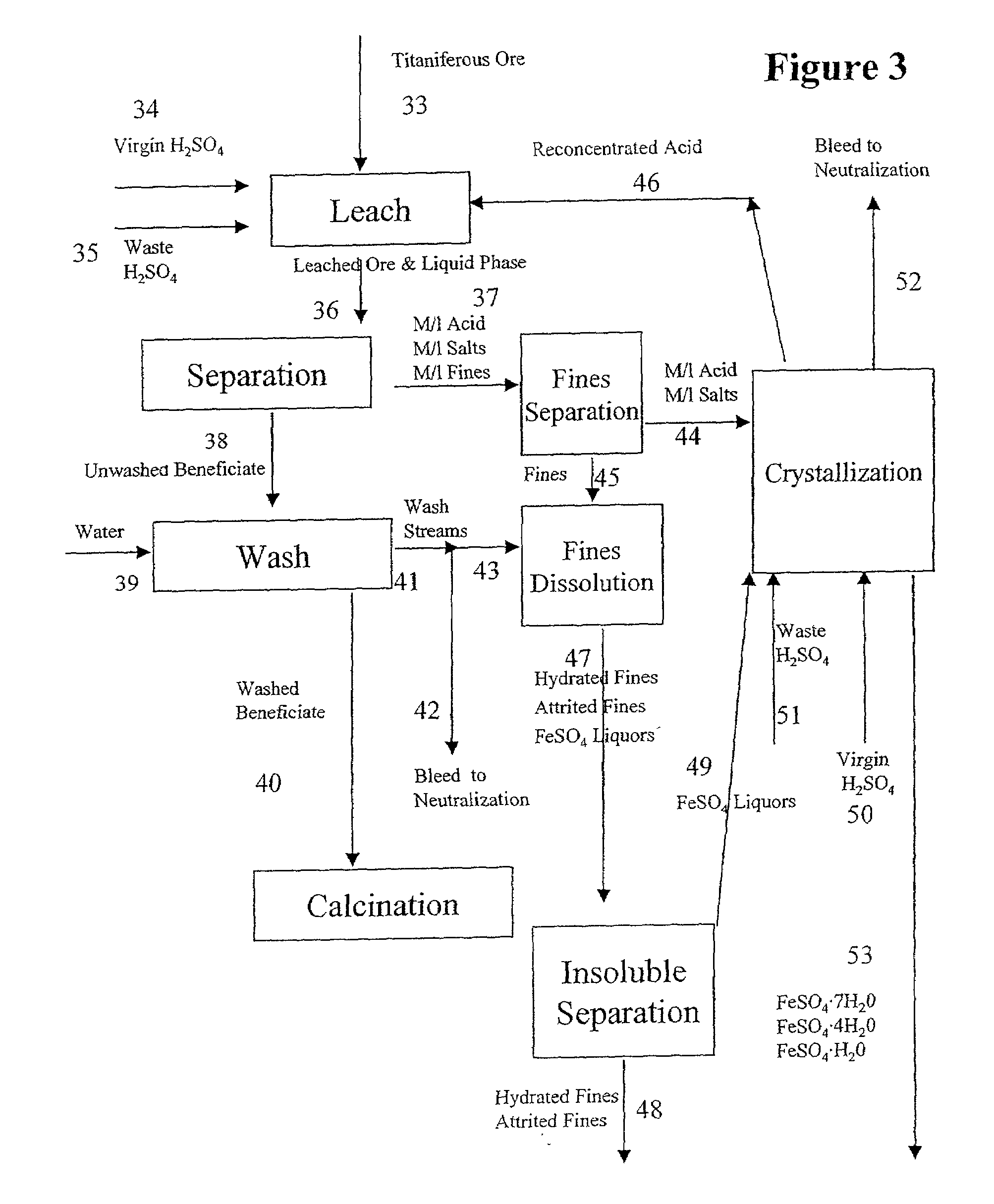Beneficiation of titaniferous ore with sulfuric acid
a technology of sulfuric acid and ore, which is applied in the field of ore beneficiation, can solve the problems of increasing capital and variable costs, reducing the scarce ore types, so as to improve the product quality and yield of titanium dioxide products, reduce processing costs, and reduce the cost of making.
- Summary
- Abstract
- Description
- Claims
- Application Information
AI Technical Summary
Benefits of technology
Problems solved by technology
Method used
Image
Examples
examples
[0087]The following examples are set forth as preferred embodiments of the invention. These embodiments are merely illustrative and are not intended and should not be construed to limit the invention in any way.
experimental example # 1
Experimental Example #1
Oxidation / Reduction Preatment without Seed
[0088]An ilmenite feedstock of the composition shown in Table 1 was oxidized at 900° C. for 1 hour and 960° C. for an additional hour. XRD analysis performed after oxidation showed the presence of pseudobrookite with no trace of ilmenite. The oxidized ilmenite was subsequently reduced at 850° C. for 1 hour and 900° C. for an additional 1.5 hours with anthracite coal. The reduced ilmenite was then cooled under an inert atmosphere and separated from the coal char via magnetic separation. Analysis of the reduced sample showed 4 at 140° C. for 5 hours. The mixture was discharged from the autoclave at a temperature of 105° C. to 107° C. and the leach mother liquor and fines were separated by decantation from the leached ore. The recovered ore was subsequently washed and calcined at 850° C. to produce a coarse grade synthetic rutile containing 96.5% TiO2 (Table 1).
[0089]The above mother liquor and fines were separated while ...
experimental example # 2
Experimental Example #2
Reduction Pretreatment with Seed, No Oxidation
[0090]An ilmenite feedstock identical to that shown in Table 2 was reduced at 850° C. for 1 hour and 900° C. for an additional 1.5 hours with anthracite coal. The reduced ilmenite was then cooled under an inert atmosphere and separated from the coal char via magnetic separation. Analysis of the reduced sample showed 4 at 140° C. for 5 hours. The mixture was discharged from the autoclave at a temperature of 105° C. to 107° C. and the leach mother liquor and fines were separated by decantation from the leached ore. The ore was subsequently washed and calcined at 850° C. to produce a coarse grade synthetic rutile containing 89.5% TiO2 (Table 2).
[0091]The above mother liquor and fines were separated via vacuum filtration. The filtration was especially difficult, requiring several hours (due most likely to a blinding of the filtration medium from the seed material in the leach). The wet basis weight of the leach fines w...
PUM
| Property | Measurement | Unit |
|---|---|---|
| Temperature | aaaaa | aaaaa |
| Temperature | aaaaa | aaaaa |
| Temperature | aaaaa | aaaaa |
Abstract
Description
Claims
Application Information
 Login to View More
Login to View More - R&D
- Intellectual Property
- Life Sciences
- Materials
- Tech Scout
- Unparalleled Data Quality
- Higher Quality Content
- 60% Fewer Hallucinations
Browse by: Latest US Patents, China's latest patents, Technical Efficacy Thesaurus, Application Domain, Technology Topic, Popular Technical Reports.
© 2025 PatSnap. All rights reserved.Legal|Privacy policy|Modern Slavery Act Transparency Statement|Sitemap|About US| Contact US: help@patsnap.com



